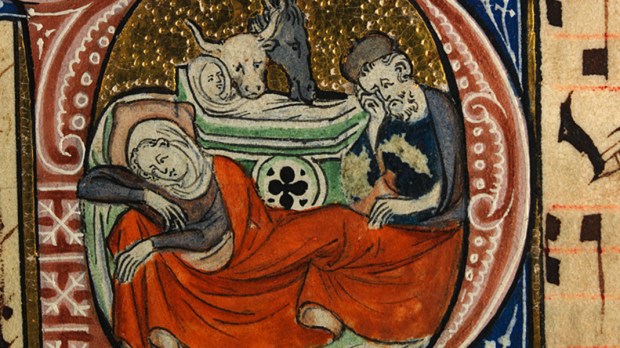What traditions does your family follow at Christmas? What sorts of meals, decorations and religious practices have you followed for as long as you can remember?
Chances are, some of these traditions can be likened to practices from the Middle Ages.
In an article at the Ancient History Encyclopedia website, Mark Cartwright details some medieval Christmas traditions from Europe.
Now, “medieval” is a very general word, and if you really want to be accurate, you’d have to determine exactly what period and which locale you’re talking about. We lose sight of the fact that before modern means of communication, customs developed very differently from one place to another.
But some of what Cartwright, who seems to be discussing medieval England, writes about is illuminating.
“Medieval holidays were a chance to have a much-needed rest from the usual daily toil and to socialize at family meals where the typical dreary menu of the poor was replaced by such rarities as meat and fish and the table of the rich was adorned with exotica like roast peacock,” Cartwright explains.
He points out that Christmas was not just one day, but was celebrated from Christmas Eve until Epiphany. “Mid-winter was a time of year which saw a lull in agricultural activity and consequently many peasants were permitted by their lord to have the entire two weeks off,” he writes.
Home decor
And since it was mid-winter, of course, the most likely natural objects brought inside for the purpose of decorating would have been evergreens such as holly, ivy, and bay leaves.
Churches would use similar decorations.
And speaking of church, one thing about services that might surprise us today is that worshipers engaged in what is called “troping.” This practice, which dates from around the 9th century, was the custom of adding extra dialogues and songs to the liturgy.
“An example of troping in the Christmas celebration was an elaboration on the question which choirs sang: Quem quaertitis in praesepe? (‘Whom do you seek in the manger?’). One half of the choir would sing the line and then the other half did. This eventually led to a dramatization using individual speakers and actors, which resulted in the presentation of Nativity plays with the Magi and King Herod playing prominent roles.”
Another play that became popular in church was The Prophets, in which a priest conducted a dialogue with various prophets such as Jeremiah, Daniel and Moses, while choir boys played dressed up bit-parts like a donkey or devil, Cartwright explains. These tropes were the origins of the English theater tradition from which Shakespeare later arose.
The meal’s the thing
After church, of course, the feasting began. If your ancestors were among the landed aristocracy, they might begin the festivities with a soup, broth or weak stew with some meat at the bottom.
The second course might be a vegetable stew (porray) of leeks and onions. The rich were fortunate enough to have meat as their next course on ordinary days — rabbit, hare and chicken, for example — but Christmas saw finer meat delicacies, fish (e.g. salmon, herring and trout) and seafood (e.g. eels, oysters and crab) courses presented to the guests. Meats were roasted on a spit over an open fire. Besides legs of beef and mutton, there was veal, venison, goose, capon, suckling pig, duck, plover, lark and crane, to name a few. A special Christmas dish the cooks might prepare to wow the guests included a boar’s head on a platter or a swan or peacock roasted in its feathers. Sauces added more flavor to many dishes and, thickened with breadcrumbs, they contained wine or vinegar, and herbs and spices.
And if they had any room for dessert, they might have enjoyed thick fruit custards, pastries, nuts, cheese and luxury fruits like oranges, figs and dates.
“There were also entremets — various decorated nibbles glazed with sugar and honey — which were served before the dessert course at Christmas and other feasts,” Cartwright notes.
Now, if your ancestors were peasants, obviously, there would not be so much indulgence. In fact, serfs were expected to give a gift to their lord at Christmas of extra bread, eggs and perhaps even a valuable rooster or a couple of hens, the author points out.
But peasants would normally enjoy some meat — a rare treat for them — along with cheese and eggs, cakes and ale. “Of the latter there was certainly lots, the brew typically made by peasant women,” says Cartwright.
For entertainment, one might see touring monks performing Bible-themed plays in private residences, with an emphasis on seasonal themes, such as the Massacre of the Innocents.
“Similarly, in cities, medieval guilds put on public pageants where wagons went through the streets carrying people dressed as personalities from the Bible’s Christmas story,” Cartwright says. “Troupes of masked pantomime artists known as mummers went through the streets, too, accompanied by bands of musicians. Sometimes numbering over 100 revelers, they dressed in outlandish costumes as lords, cardinals and knights, and even ventured into people’s homes to dance and play dice. Receiving food and drink in return for their entertainment, mummers often performed short plays with scenes from familiar legends such as Saint George and the dragon.”
Back to the grindstone
All the fun and games had to be set aside, of course, at the end of the fortnight. But people found ways to ease back into the old routine in the new year. One neat trick, for example, was to hold a plough race at sunrise on the first Monday after Epiphany. Thus, that day came to be known as Plough Monday.
“There was another tradition, perhaps again to lighten the burden of returning to the daily toil, on 7th January, also known as Saint Distaff’s Day,” Cartwright explains. “This day was a day of carnival, an occasion for ‘misrule,’ for ‘comic battles between the sexes’ in which men set fire to women’s flax and women made sure men got soaked.”
And so life settled down again into its workday routine, at least for a few more weeks, until Shrove Tuesday would herald the beginning of Lent.

Read more:
7 Advent traditions that are easy to do at home

Read more:
5 Beautiful Christmas traditions and their origins

